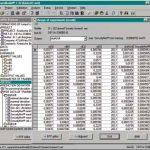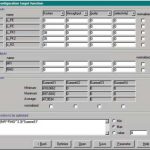Recipes play a key role in many areas of chemical production. The main problem here is the difficulty of controlling a large number of parameters such as to maximise product quality while minimising production costs. Following the development of a new kind of algorithm a software-based standard solution for this type of problem is now available.
Thomas Froese
The abundance of parameters which have to be controlled during recipe optimisation makes it hard to find the correct parameter combination for product development and for optimising the production process. Each additional parameter to be controlled increases the number of required tests by at least a factor of 3. The conventional approach for finding solutions to this type of problem consists of empirical tests based on assumptions. This method does not always test all of the relevant combinations, how-ever. The quality which is actually achieved is therefore lower than the quality that is theoretically possible.
Modelling with neural networks
By using a neural network a model can be computed from the recipe, even if only a few test records are available. With the help of an optimiser, this model is then able to com-pute the set of parameters which represents the best compromise between quality and cost. In order to create the model, the records have to be read into the NeuroModel( software package. The records are then verified for consistency. An error range-based cluster algorithm checks whether the product quality varies for identical or similar sets of parameters. If the records reveal this to be a frequent occurrence, NeuroModel alerts the user that he or she may not have taken all variables into account. Isolated tests that contradict one another are removed by the cluster algorithm. After the cluster process has ended, a fully automatic teach-in procedure that adapts the model to the complexity of the problem is started. As a result of this procedure, NeuroModel creates a model file, which is given a *.net extension and saved.
A sensitivity analysis with an integrated pruning function investigates which model inputs (i.e. recipe variables) have absolutely no influence on the output variables (i.e. product quality). These input variables are then automatically removed and the remaining relevant variables are used to compute the final model. The user can employ a sensitivity analysis and causality graphics for examining the correlation between the recipe variables and product quality. The sensitivity analysis supplies the user with a table, which shows the average sensitivity of each model output (quality) to changes in each model input (recipe parameter). The table can be represented as a graph and documented in a system-immanent word-processing program with a simple mouse click. It can be saved in the form of a graph or a table. Tables and graphics can also be copied to external spreadsheets or word-processing programs
via the clipboard (Fig. 1).
The causality graphics function allows the user to create 2 or 3-dimensional sections of the model; SecurityNet(r) values (confidence intervals) can be shown in addition to the normal model prediction. The user can thus establish the exactness of model at the examined point. The SecurityNet value is scaled in the unit and order of magnitude of the output variable, enabling the model output to be interpreted directly as a variable 6 SecurityNet interval.
The genetic recipe optimiser function
NeuroModel Version 1.3 optionally includes a genetic optimiser as an additional analysis function. This optimiser enables the user to compute the optimum recipe by entering specific constraints and a configurable target function.
To do so, the user must first open the dialog for configuring the constraints. This dialog permits the optimiser’s search range to be restricted, in order to exclude parameter combinations that, for example, are mathematically or physically impossible (Fig. 2). Furthermore, the value range within which model test records were available must not be exceeded by a significant amount.
The system executes useful basic configurations automatically in this dialog. Other helpful restrictions, for instance that the total weight of a 100 kg mixture should not exceed 100kg, are offered in simple dialogs. If additional functional correlations are required, the user can employ a parser, which permits and desired links to be activated be-tween constant factors (e.g. prices) and model inputs and outputs.
The user can configure the target function with a formula parser (Fig. 3). This parser allows any desired formula to be entered with the aid of inputs, outputs, column totals (e.g. for price evaluation) and constant factors.
When the user has finished configuring this dialog, the search algorithm is started. It then presents a ready-to-use recipe that observes all configured constraints and represents an optimal point.
If the SecurityNet value of the model is too high here, i.e. if the model is too inaccurate at the specified position, the user must run a test at the point which exhibits the estimated quality improvement. The calculated result must then be used to improve the neural model. The optimiser is run once more for the new model and a new recipe is generated. This new recipe is then subjected to another test. This procedure is repeated until the model reaction at the point specified by the optimiser has been optimised.
Applications of the neural model
The finished neural model can be used in many different ways. It can be imported into an Excel table with the help of an Excel add-in, for example. The user simply has to load the add-in and then use a typical Excel formula, e.g. containing the term =NeuroModel(„Model.net“;1;A1;B1;…;X1). This function also permits Excel’s own optimiser to be used and Excel graphs with different correlations to be generated. NeuroModel offers several runtime packages, that can be ported by various process control systems and programmable logic controllers or alternatively linked to them.
The user can thus create complete solutions using a single software package – from data analysis through test planning and offline model optimisation to integration in control strategies.
Atlan-tec
Fax: ++49/2154/9248100
Further information cpp-276
Unsere Webinar-Empfehlung
Die Websession „Wasserstoff in der Chemie – Anlagen, Komponenten, Dienstleistungen“ (hier als Webcast abrufbar) zeigt technische Lösungen auf, die die Herstellung und Handhabung von Wasserstoff in der chemischen Industrie sicher machen und wirtschaftlich gestalten.
Ob effizienter…
Teilen:













